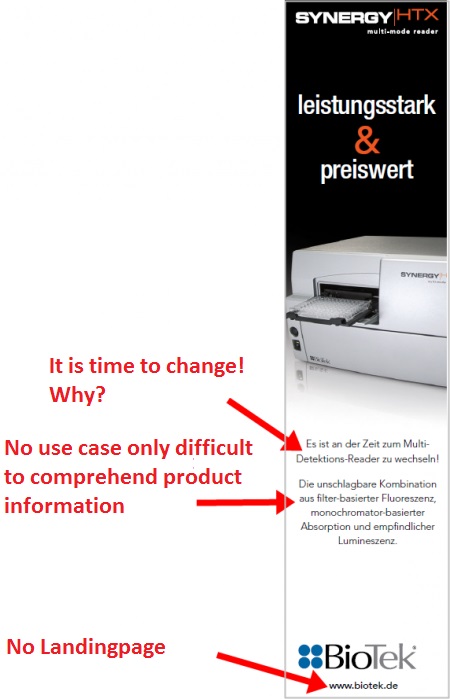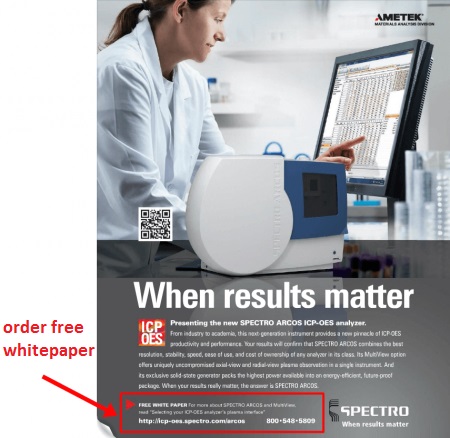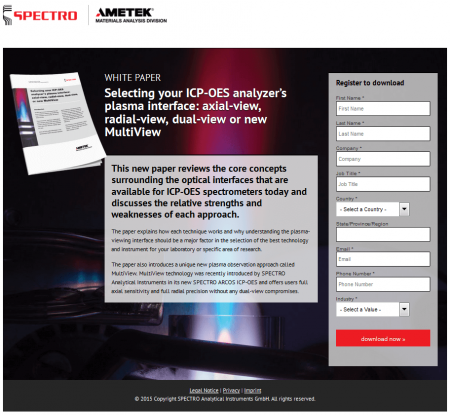
I have showed you before how to make advertising campaigns more successful by using dedicated landing pages. But the subject won’t let me go. Often I get the impression that decision makers are not particularly interested in the success of their B2B campaigns. Why do I believe so? Every day I spot ineffective B2B advertisements, many of which were created with a huge input of human and financial resources. Many e-mail shots contain only a link to further information and print media ads only a website URL, probably because decision makers do not bother to click on anything themselves. Otherwise they would immediately see that those links and URLs are real sales lead preventers because they lead potential customers astray. Irritated people don’t become sales leads.
Such things don’t happen at our company!
You don’t believe me? Well, then I’ll show you a few examples. You might be thinking: “Such things don’t happen at our company.” I’d suggest to take a closer look next time your company starts an advertising campaign. You’ll be amazed – and hopefully draw the right conclusions. Because there is a simple way to put a stop to sales lead destruction and to generate more leads: a professional landing page.
Every B2B advertising campaign needs a landing page
You do print media advertising? Alright, in that case you need a landing page to convert anonymous but interested readers into actual sales leads. The same applies to direct e-mail campaigns, banner advertising, Google AdWord campaigns and even old-fashioned advertising letters sent by post. All potential customers must be shuttled to a landing page. Only this allows you to send them appropriate information as new sales leads.
What is a landing page?
A landing page is not just any page on your website. Its contents are reduced to an absolute minimum. Visitors of the page should not get distracted by too much available information or the navigation elements of a normal website. A landing page is individually created for a particular campaign. That’s how to unfold a landing page’s full potential and thus generate the leads that your sales team want.
Key elements of a landing page
A landing page (target page) is designed to tease the visitor of the web page to want to know more, which is why it should not deliver too much information. Every landing page should contain a call to action (CTA) for visitors to request, for example, a brochure. To this end, the potential customer must fill in an online contact form on the landing page. The way to access a landing page is by
- entering the URL given in the advertisement into an internet browser, for example Internet Explorer or Google Chrome or by
- clicking on an online banner, a hyperlink or a button (“More information” or similar) in an e-mail.
Why you need a custom-made landing page for each campaign
Imagine taking your best friend out for a meal in a newly opened Mexican restaurant. You noticed an ad in your newspaper promising “Original Mexican food & beverages at their best” and are looking forward to your evening out. But when you enter the restaurant …

Big disappointment: not an original Mexican dish
you find that the interior and the furniture have been taken over from the previous tenant, who ran a non-descript fast food place. The beer on tap is also still the same local brand and what you see served at the next table looks more like hamburgers than tacos. You’d be disappointed, right?
This is how your potential new customers react when they go to the web page you had suggested and don’t find what you had promised them in your ad.
Keep promises and meet expectations
If you are advertising a product called “Hyper123”, your potential buyers will expect to find information specifically about this device directly on the landing page. Sending them instead to your company’s homepage, from where it takes several annoying clicks to navigate through your website, will confuse them and cause them to move on within seconds.
This is how opportunities are wasted and your sales team ends up with nothing
My point is best explained using a real-life example. The company BioTek advertised a new device, the SYNERGY HTX multi-mode reader, in the German-language magazine “LaborJournal”. The ad looks good but requires extensive technical knowledge to be understood. The reader needs to know which benefits the unbeatable combination of “filter-based fluorescence, monochromator-based absorbance and sensitive luminescence” offers. The ad gives the company homepage www.biotek.com as the only contacting option.

Print media ad to stimulate interest in a new device
So what happens after you enter the URL? That’s right, you get to the homepage of the company, from where you have to tediously click your way through to the product page. Few actually go all the way. A lot of money was wasted on the ad and the sales team is probably still wondering why it never received any sales leads.

This is no landing page – this irritates potential buyers
What about your own company’s advertising activities? Take a closer look when you next place an advertisement or send out an e-mail shot. Do you have sales lead destroyers at work?
How advertisements and good landing pages complement each other
To be able to show a positive example, I had to look for a while. I found something suitable only in the third magazine I went through. In “American Laboratory”, the company Spectro advertises the new SPECTRO ARCOS and offers a white paper for download via a given link. Potential customers clearly expect: I can get the white paper through this link.

Advertisement containing a link to a landing page
After entering the provided URL into my browser, I was directed to a real landing page and immediately saw that this was what I was looking for:
- An image of the promised white paper
- The keyword “White Paper” at the top of the page
- A brief description of the contents
My expectations had been fully met, so I proceeded with filling in the form.

A well-devised landing page supports conversion and generates sales leads
The bottom line
Landing pages are highly important to gain sales leads and are worth the extra effort of creating to purpose. It’s surprising that even market leaders do not consistently use this marketing tool.
What’s the reason? In one of the next blog posts I’ll go into creating landing pages in more detail. Does this subject interest you? I look forward to your questions and suggestions in the comments field.




